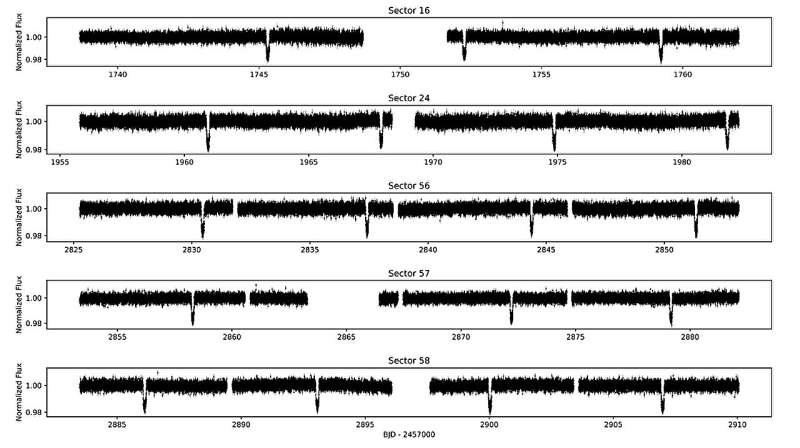
TESS 2 min cadence PDCSAP light curves for TOI-1420. Transit events are visible roughly every 7 days. Credit: Yoshida et al., 2023.
Using NASA’s Transiting Exoplanet Survey Satellite (TESS), an international team of astronomers has detected a new exoplanet orbiting a distant star. The newfound alien world, designated TOI-1420 b, has an exceptionally low density. The finding is reported in a paper published September 18 on the pre-print server arXiv.
TESS is conducting a survey of about 200,000 of the brightest stars near the sun with the aim of searching for transiting exoplanets. So far, it has identified nearly 6,800 candidate exoplanets (TESS Objects of Interest, or TOI), of which 385 have been confirmed so far.
Now, a group of astronomers led by Stephanie Yoshida of the Harvard-Smithsonian Center for Astrophysics (CfA) in Cambridge, Massachusetts, reports the confirmation of another planet monitored by TESS. The team has identified a transit signal in the light curve of TOI-1420—a late G-dwarf star about 658 light years away. The planetary nature of this signal was validated by follow-up observations using various telescopes.
“We have confirmed TOI-1420b as an exceptionally low-density planet in a 6.96 day orbit around a late G dwarf,” the researchers wrote in the paper.
TOI-1420 b has a radius of about 11.89 Earth radii and a mass of around 25.1 Earth masses, what yields an ultra-low density of only 0.082 g/cm3. The planet orbits its host at a distance of 0.07 AU from it and has an equilibrium temperature of about 957 K.
The astronomers underlined that TOI-1420 b is the largest-known planet with a mass less than 50 Earth masses. The planet’s low density suggests that it contains a sizable envelope of hydrogen and helium. Using planetary structure models, the researchers estimate that TOI-1420 b has a large envelope mass fraction of approximately 0.82, what implies a core mass of 4.0 Earth masses.
When it comes to the parent star TOI-1420, it is comparable in size and mass to the sun. The star has an effective temperature of about 5,510 K and a metallicity at a level of 0.28. The age of TOI-1420 is not well constrained, however, the authors of the paper estimate that the star is not older than 10.7 billion years.
Summing up the results, the scientists noted that low-density planets like TOI-1420 b are an excellent target for future atmospheric characterization and dynamical studies, given that they are more susceptible to outflows than higher-gravity planets.
“In all, TOI-1420 b presents a number of exciting future prospects for atmospheric and dynamical characterization. Comparative planetology of TOI-1420 b, WASP-107 b, and other similarly low-density worlds will ultimately help unveil their formation and evolution histories,” the researchers concluded.
More information:
Stephanie Yoshida et al, TESS Spots a Super-Puff: The Remarkably Low Density of TOI-1420b, arXiv (2023). DOI: 10.48550/arxiv.2309.09945
Journal information:
arXiv
© 2023 Science X Network
Citation:
New low-density exoplanet discovered with TESS (2023, September 25)
retrieved 25 September 2023
from https://phys.org/news/2023-09-low-density-exoplanet-tess.html
This document is subject to copyright. Apart from any fair dealing for the purpose of private study or research, no
part may be reproduced without the written permission. The content is provided for information purposes only.
>>> Read full article>>>
Copyright for syndicated content belongs to the linked Source : Phys.org – https://phys.org/news/2023-09-low-density-exoplanet-tess.html
